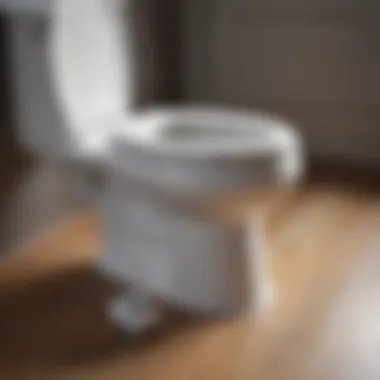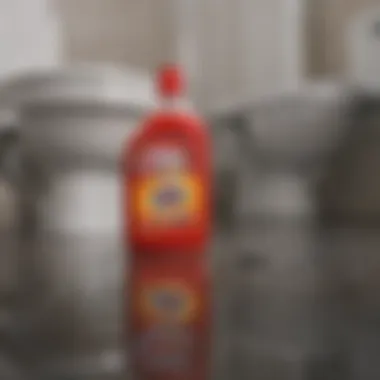The Use of Drano for Unclogging Toilets: An Analytical Approach


Intro
In addressing home maintenance issues, the effectiveness and safety of using Drano for unclogging toilets often come into question. This article seeks to guide homeowners through the analytical lens of Drano's application, breaking down the chemical composition behind the product, the mechanisms of typical toilet clogs, and the potential risks that may arise from using commercial drain cleaners. A deeper understanding can help in making informed decisions for toilet maintenance.
Understanding Toilet Clogs
Toilet clogs can occur from various reasons. Some common contributors include excess toilet paper, foreign objects, or certain types of human waste not breaking down properly. Understanding the cause of clogs can assist in determining the best course of action.
Types of Clogs
- ** soft clogs**: These result from breakdown products such as toilet paper and waste.
- Hard clogs: In these instances, objects such as toys or sanitary products block flow.
- Greasy clogs: Though less common in sanitation lines, thick residue amassed over time can create blockages.
Identifying the type of clog is essential before attempting any solutions. This clarity also aids in preventing future occurrences.
Chemical Compounds in Drano
Drano is primarily known for its strong chemical composition. Key components often include sodium hydroxide, aluminum, and sodium nitrate. These substances work together to break down organic matter and clear clogging. While potent, the mixture can also damage particular toilet systems, especially if used recklessly or too frequently. Understanding these chemicals and their impacts is critical for safe application.
Safety Concerns
Using Drano requires cautious handling due to designated hazards associated with it:
- Eye Irritant: The chemicals can cause severe injury if splashed into the eyes.
- Respiratory Issues: Fumes from Drano may irritate the lungs if not handled in a well-ventilated area.
- Pipe Corrosion: Frequent use may harm the internal structure of pipes over time, potentially leading to unanticipated repairs.
Analyzing the Pros and Cons
When considering Drano for unclogging toilets, it is vital to encompass key points of assessment:
Pros
- Quick resolution of clogging issues
- High efficiency in breaking down organic materials
Cons
- Potential damage to toilet infrastructure
- Chemical burns or health risks if mishandled.
- A temporary fix that may necessitate a more thorough query later.
Prolusion to Toilet Clogs
Toilet clogs are a common household issue that can cause significant discomfort and inconvenience. Understanding the nature of toilet clogs helps homeowners to address them quickly and effectively. Not only can a clog lead to an unpleasant situation, but it may also indicate larger plumbing problems. Analyzing the causes and types of clogs can therefore inform better responses, especially when considering the use of chemical solutions, such as Drano.
Understanding Common Causes
Several factors typically contribute to toilet clogs. Most commonly, excess toilet paper usage can overwhelm the plumbing system. It is crucial to appreciate that not all toilet paper varieties disintegrate easily in water. Additionally, foreign objects frequently create blockages; toys, personal hygiene products, or excessive items often end up in toilets due to improper disposal practices. This not only causes clogs but also can damage plumbing.
Sometimes, the build-up of minerals, especially in areas with hard water, can lead to drainage issues. Over time, these minerals accumulate within pipes, narrowing the flow space and causing clogged toilets. Keeping these factors in mind can assist homeowners in both prevention and acquired measures for effective problem resolution.
Types of Toilet Clogs
Toilet clogs fall into several distinct categories, allowing for the identification of suitable solutions. Partial clogs occur when water can still flow through but at a reduced rate. Typically, this is seen when a small amount of blockage is present. Homeowners can often remedy these types of clogs by using a plunger or infrequent applications of chemical drain cleaners.


Complete clogs block all water flow and require immediate attention. This situation often progresses into complete waste backup, which can create a hygiene problem in addition to inconvenience. Their removal may involve specialized tools, such as a toilet auger, or, in some cases, may require professional intervention.
Tree root invasions also pose a unique challenge, especially in older homes with aging plumbing systems. Roots permeate tiny cracks in pipes, leading to severe blockage issues that common home remedies cannot easily address. Identifying type of clogs correctly can swing the pendulum in favor of an effective solution and increase one’s success rate in resolving such nuisances.
Overview of Drano
Understanding Drano's characteristics is crucial. Many homeowners encounter clogged toilets and may consider this product as a quick fix. However, comprehending its basic elements, advantages, and the correct usage can significantly impact the effectiveness and safety of it's application.
Chemical Composition
Drano is primarily composed of sodium hydroxide, sodium nitrate, and aluminum.
- Sodium Hydroxide: Often referred to as caustic soda, this is the main active ingredient. It works by generating heat through a chemical reaction, effectively dissolving organic matter and grease in clogs.
- Sodium Nitrate: This acts as a stabilizer, enhancing the solution's effectiveness and maintaining its chemical properties.
- Aluminum: Small strips of aluminum are mixed. Upon contact with moisture, they produce gases that help remove obstructions in pipes.
This combination can be effective against soft clogs like hair, soap, or food. Nevertheless, it is less efficient against solid obstructions such as toilet paper or foreign objects. Knowing the components helps foster knowledge about what situations this product suits best.
Mechanism of Action
The mechanism employed by Drano involves several stages:
Initially, the sodium hydroxide reacts with water when poured into the toilet, creating an exothermic reaction. This reaction generates heat, which softens and eventually breaks down the materials causing the blockage. The production of gas bubbles from aluminum further accelerates the reaction, disrupting standing water and assisting in breaking apart tough clogs.
While this chemical reaction can be effective, some risks accompany its use, particularly in toilets. Solid blockages may not yield well to this method. In those scenarios, it's crucial to understand other available alternatives for effective clog removal. Understanding the functioning of Drano can aid you in assessing when it's better to use this product versus opting for more traditional unclogging methods.
Can You Use Drano for Toilets?
The question of whether Drano can be used for toilets is a critical one for homeowners. As unwanted blockages arise, the urgency to resolve them leads many to consider various solutions, Drano included. In this section, it is important to explore the implications, the potential benefits, and necessary actions to take when thinking about using Drano in toilets.
First, understanding manufacturer recommendations can guide homeowners in safety and effectiveness. This information establishes an informed approach to addressing clogs.
Second, examining consumer experiences will provide real-world insights. Often, personal accounts elucidate the impact or efficiency of products under different circumstances. These user perspectives reveal valuable details not covered in promotional material, indicating whether Drano truly competently unclogs toilets.
Therefore, unpacking these areas contributes significantly to making sound choices regarding toilet maintenance and repair while helping homeowners avoid costly mistakes or safety hazards.
Manufacturer Recommendations
Manufacturer guidance is essential when seeking effective and safe approaches to unclog toilets with Drano. The Drano product line, including formulations such as Drano Max Gel, addresses clear clogged drains mostly intended for sinks and tubs. Directing this product towards toilets, however, diverges from intended use.
Key Points:
- Product Labels: Always read product labels and heed warning instructions.
- Not Recommended: Many sources, including manufacturer guidance, discourage using Drano in toilets due to the harsh effects of chemicals on ceramic or porcelain.
- Chemical Reactions: The sodium hydroxide and other potent ingredients can react adversely with toilet mechanisms, causing internal damage or compromising the plumbing seal.
- Seek Alternatives: The National Association of Home Builders also suggests considering alternatives tailored specifically for toilets rather than relying on products associated primarily with drains.
Invaluable information often found in the manufacturer recommendations tells us that curb superficial remedies, especially when facing more intricate plumbing and design challenges in toilets.
Consumer Experiences
Investigating consumer experiences provides an unvarnished look at the reality of using Drano in toilets. Discussions online, particularly in forums such as Reddit, unveil varying success stories along with failures that yield learning opportunities.
Risks of Using Drano in Toilets
The consideration of using Drano in toilets is a subject of critical importance. Homeowners should weigh the potential benefits against the considerable risks linked with its application. While Drano may promise a quick solution for clogs, an in-depth examination reveals that the implications can transcend beyond mere plumbing problems. Understanding the possible complications with plumbing and health is essential for informed decision-making. This section will elaborate on these risks to guide homeowners in their approaches to unclogging.


Potential Damage to Plumbing
When utilizing Drano for unclogging toilets, the risk of damaging plumbing is significant. The highly corrosive chemicals in Drano are engineered to break down tough clogs of hair, grease, and foreign materials in drains. However, this strength comes at a cost to plumbing systems.
Key concerns include:
- Corrosive Effects: Persistent exposure to Drano can erode pipes and fixtures. This is especially true in older plumbing systems made from less resistant materials.
- Surface Damage: It may negatively affect the interior surfaces of pipes, potentially leading to leaks over time.
- Clog Complications: Instead of resolving clogs, Drano can form thicker residue, complicating the initial blockage and making it more comprehensive when tackling future issues. It's advisable to consider these plumbing concerns before using products like Drano indiscriminately.
Health Risks and Safety Precautions
While addressing clogs, the usage of Drano poses not only mechanical dangers but also health risks that should not be dismissed. When safety is overlooked, it can result in serious consequences.
Noteworthy health risks are:
- Chemical Exposure: Drano contains substances such as sodium hydroxide that can provoke severe reactions upon skin contact or inhalation. Protective gear, such as gloves and masks, should be utilized.
- Fumes and Vapors: In enclosed spaces, the evaporation of high-strength chemical cleaners can lead to impairement of respiratory functions. Ensure that spaces are properly ventilated.
- Accidental Ingestion: Children and pets may inadvertently consume residual products left in the toilet or nearby surfaces. This highlights the importance of keeping these products out of reach.
It is wise to heed detailed guidelines when using Drano or similar chemicals. Following proper safety and precautionary measures can mitigate risks, ensuring a safer home environment.
Through acknowledging the risks of utilizing Drano in toilets, homeowners can educate themselves better on adequate solutions. Weighing the potential damage to plumbing and health considerations empowers individuals to make smarter choices in their search for clogged toilet remedies.
Alternative Methods for Unclogging Toilets
Understanding alternatives to Drano is crucial, considering the potential drawbacks of using chemical drain cleaners. Many homeowners seek solutions that avoid any risks to their plumbing or health. Here, we examine several effective methods for unclogging toilets that do not involve harsh chemicals and highlight their key benefits and considerations.
Plungers: When and How to Use
Plungers are often the first line of defense against clogged toilets. Their simplicity and effectiveness make them a valuable tool for any homeowner. A cup plunger is typically used for toilets, while a flange plunger offers greater suction.
To use a plunger effectively:
- Position: Ensure there is enough water in the bowl; then insert the plunger
- Sealing: Create an airtight seal around the drain hole
- Pump: Use quick, forceful thrusts to push water in, then pull it back to create suction
- Repeat: Make multiple attempts, if needed, until the clog is dislodged
It's important to maintain a decent but not excessive force throughout the process. Over-exertion can damage the toilet.
Drain Snakes: Effectiveness and Usage
Drain snakes, also known as augers, are hand tools designed for clearing deeper clogs. They consist of a flexible metal cable fitted with a spiral end that navigates the curved pipes of toilets. A plumber’s snake can reach farther than a plunger can.
The effectiveness of a drain snake lies in its design:
- Versatility: It can clear stiffer clogs made of toilet paper, hair, or foreign objects
- Expansion: Can reach areas that plungers often struggle to
To use a drain snake:
- Insert: Guide the spiral end into the toilet bowl's drain
- Twist: Turn the handle to allow the snake to grab the clog
- Pull: Gently pull back the snake to remove any blocked material
Use caution, as aggressive usage can scratch the toilet bowl.
DIY Home Remedies


There are various DIY remedies that use common household items. They often pose minimal risk while addressing minor clogs effectively. Notable options include:
- Baking soda and vinegar: Combine a cup of both and pour into the toilet. Allow it to sit to break down waste.
- Hot water: Pouring hot (not boiling) water into the bowl can help soften any solidified waste without damaging the porcelain.
While these methods may not work for tough clogs, they represent a safer alternative to commercial drain cleaners and can be effective for regular maintenance.
By exploring these alternative methods, homeowners can better address and maintain their toilet system while avoiding the risks associated with chemical unclogging solutions. Implementing these strategies enriches knowledge about household plumbing concerns.
Best Practices for Preventing Toilet Clogs
Preventing toilet clogs is a proactive approach that every homeowner should prioritize. Clogs can lead to unwanted messes, significant inconvenience, and costly plumbing repairs. Carefully considering maintenance strategies can save time and resources in the long run. Implementing best practices reduces the risk of clogs and promotes the overall health of your plumbing system.
Regular Maintenance Tips
Toilets, like all plumbing fixtures, require routine care. Paying attention to their condition can help identify issues early. Here are some effective maintenance tips:
- Routine Inspection: Check your toilet for any signs of wear or malfunction at least once a month. Look for leaks around the base or connections.
- Use a Plunger: Familiarizing yourself with a plunger and using it regularly can help ensure minor build-ups do not lead to major clogs later.
- Keep the Tank Clean: Regularly cleaning the inside of the toilet tank can prevent rust and sediment build-up.
- Use Sorting Solutions: Avoid flushing anything other than human waste and toilet paper. This rule reduces clogs from inappropriate materials.
Maintaining consistent habits can help prevent many common clogs, leading to a smoother plumbing experience.
Educating Household Members
Educating everyone in the household is critical to mitigating unnecessary toilet clogs. Sharing knowledge reinforces proper usage best practices. Here are some strategies:
- Create Clear Guidelines: Establish what can or cannot be flushed down the toilet. Make it clear to everyone, especially children, to only use the toilet as intended.
- Discuss Consequences: Help them understand the potential problems associated with clogs—these can include back flow, overflow, and plumbing issues that may arise from neglect.
- Involve Them in Maintenance: Encourage participation in routine maintenance tasks. Making this a family activity teaches responsibilities and reinforces the importance of caring for the plumbing.
Investing time in education pays off. Practices established at home lead to long-term benefits in preventing clogs and ensuring a hassle-free toilet experience.
Following these best practices can significantly minimize the risk of toilet clogs. Regular maintenance alongside individual accountability creates a more functional and user-friendly bathroom environment.
Finale
The conclusion serves a critical function in reinforcing the significance of the topic regarding Drano's use for unclogging toilets. After delving into the intricate details of Drano's chemical composition, its mechanisms, and the potential hazards it carries, it becomes clear that informed decisions are paramount for homeowners.
Understanding your sanitation facilities are a important home decor aspect sets the context. Toilets are more than just functional items; they reflect hygiene standards and a safe environment. A clog not only causes inconvenience but can lead to significant worst-case scenarios if ignored. It is reasonable for one to seek quick fixes, like commercial drain cleaners, knowing the ramifications discussed throughout the sections.
This article ventures beyond just Drano's effectiveness as a drain clearner. It navigated through various alternative unclogging methods alongside best practices for maintenance. With risks as a foremost theme, the potential repercussions of using chemical solutions in plumbing systems were thoroughly examined. Judicious practices should be adopted to minimize damage to plumbing while maintaining a clean and functional restroom.
Reading this article should inspire a proactive attitude toward toilet maintenance. Educating household members to practice careful flushing habits and addressing issues promptly significantly reduces the likelihood of severe clogs. Hence, thoughtful engagement guarantees that one safeguards both their plumbing system and overall well-being.
Summary of Findings
In the exploration of Drano as an unclogging agent for toilets, this article examined several crucial aspects:
- Chemical Composition of Drano: A severe drain cleaner primarily made of sodium hydroxide, the understanding of its active ingredients is mandatory to appreciate its strength and corrosiveness. Mechanism of Action: Highlighted how Drano creates heat that helps dissolve blockages, thus impacting its efficiency on different types of clogs.
- Manufacturer and Consumer Perspectives: While some consider Drano effective, many are deterred by warnings emphasizing plumbing damage and side effects, likening a usage well-implemented causes for cautious reliance.
- health Risks: Contributors towards safety health measures are significant when utilizing such commercial products other than regular maneuvers as summarized before that should always prioritize both personal and plumbing safety.
The discussion around alternative unclogging methods further elucidated viable options, underscoring points toward plungers, drain snakes, or DIY remedies stand excellent alternatives under complex clogs scenarios, fostering a more holistic approach.
Since consumer safety remains a priority across various households, best practices in toilet maintenance prompt successful long-inducing solutions, encompassing regular checks through implementing thorough cultural knowledge among residents toward reducing troublesome occurrences.
Final Recommendations
To effectively maintain toilets and mitigate clogging issues, homeowners should consider the following recommendations:
- Opt for mechanical unclogging solutions first. Tools like plungers and drain snakes can often resolve issues without risking plumbing integrity. They are effective and usually environmentally friendly.
- Maintain plumbing regularly. Routine inspections and cleanings act as preventative measures, ensuring issues are kept at bay before they arise.
- Engage family in education. Instructing household members on what can or cannot be flushed is crucial. Ensuring clear communication and reinforcing proper flushing etiquette minimizes clogs while maintaining hygiene levels.
- Research alternatives. If faced with a stubborn clog that does not yield to traditional methods, alternative products designed for toilets can minimize risks without harmful chemical interactions.
- Be cautious with chemistry. If resorting to chemical solutions like Drano, understanding the possible physical reactions within the plumbing is imperative. Only use it when absolutely necessary and follow safety protocols strictly—consider jobbing the task to professional services available if uncertain.
Engaging in deliberate practices ensures better maintenance, wise product implementation, and overall well-being in the home environment. Regular vigilance retains both plumbing system integrity while prolonging peace of mind on the overall attributed comfort towards effectively managing behaves within internal structures of the restroom system.



